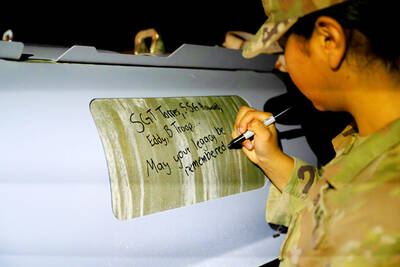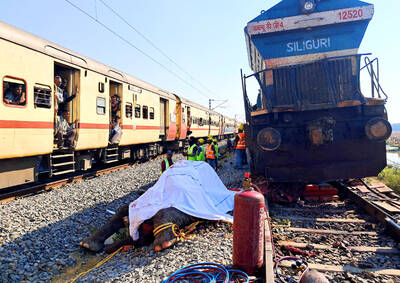Thousands of demonstrators, some wearing gas masks, marched on Japan’s parliament yesterday, where they formed a human chain to protest the use of nuclear power after the Fukushima Dai-ichi nuclear power plant crisis.
They marched through Tokyo chanting: “We don’t need nuclear power” and “stop operating nuclear plants,” in the latest demonstration since a recent decision to resume the use of nuclear power in Japan following a total shutdown.
The protesters were also wearing white protective suits similar to those used by decontamination workers at the crippled Fukushima plant, and drummed on yellow barrels emblazoned with atomic waste warnings.
Journalists estimated there were at least 10,000 demonstrators in the early stages of the march. They formed a human chain around the parliament in the evening.
“After the Fukushima disaster, I thought that the government and vested interests were telling us lies about nuclear power being safe,” said Miho Igarashi, 46, an architect from Ibaraki Prefecture, south of Fukushima.
“We have to raise our voices against” the danger of atomic power, she said.
The rally is the latest in a string of protests in Japan, which has seen a rising tide of anti-nuclear sentiment since Japanese Prime Minister Yoshihiko Noda last month ordered the restart of two reactors.
Noda defended the move, citing looming power shortages after Japan switched off its 50 nuclear reactors, which provided the resource-poor country with a third of its energy, in the wake of the disaster.
Weekly demonstrations outside the prime minister’s residence have drawn tens of thousands of people and a rally in west Tokyo earlier this month saw a crowd that organizers claimed was about 170,000-strong.
Yesterday’s protest took place in high temperatures under a blazing sun and the crowd included families with small children.
“I decided to join the protest because nuclear reactors are resuming, even though their safety is not guaranteed,” said Sayaka Suzuki, 28, who was with her three-year-old daughter.
The latest rally comes less than a week after a damning government-backed report on last year’s crisis said Japanese officials and Tokyo Electric Power Co (TEPCO), operator of the crippled Fukushima Dai-ichi plant, ignored the risk of an atomic accident because they believed in the “myth of nuclear safety.”
A separate parliamentary report said the worst nuclear accident in a generation was a man-made disaster, marked by a lack of oversight and collusion between TEPCO, the government and regulators.
The giant utility largely cleared itself of blame, saying the size of last year’s earthquake and tsunami was beyond all expectations and could not have reasonably been foreseen.
A magnitude 9.0 earthquake and tsunami on March 11 last year crippled cooling equipment at the Fukushima Dai-ichi plant, triggering meltdowns that spewed radioactivity and forced tens of thousands of residents to flee.
The rising anti-nuclear sentiment in Japan has also led to the launch of Greens Japan, a political organization aiming to field candidates with an environmental agenda in parliamentary elections.
“A party that strongly pursues environmental policies is needed,” Akira Miyabe, the group’s 59-year-old deputy head, was quoted by Kyodo News as saying at an inaugural meeting on Saturday.

The Burmese junta has said that detained former leader Aung San Suu Kyi is “in good health,” a day after her son said he has received little information about the 80-year-old’s condition and fears she could die without him knowing. In an interview in Tokyo earlier this week, Kim Aris said he had not heard from his mother in years and believes she is being held incommunicado in the capital, Naypyidaw. Aung San Suu Kyi, a Nobel Peace Prize laureate, was detained after a 2021 military coup that ousted her elected civilian government and sparked a civil war. She is serving a

REVENGE: Trump said he had the support of the Syrian government for the strikes, which took place in response to an Islamic State attack on US soldiers last week The US launched large-scale airstrikes on more than 70 targets across Syria, the Pentagon said on Friday, fulfilling US President Donald Trump’s vow to strike back after the killing of two US soldiers. “This is not the beginning of a war — it is a declaration of vengeance,” US Secretary of Defense Pete Hegseth wrote on social media. “Today, we hunted and we killed our enemies. Lots of them. And we will continue.” The US Central Command said that fighter jets, attack helicopters and artillery targeted ISIS infrastructure and weapon sites. “All terrorists who are evil enough to attack Americans are hereby warned

Seven wild Asiatic elephants were killed and a calf was injured when a high-speed passenger train collided with a herd crossing the tracks in India’s northeastern state of Assam early yesterday, local authorities said. The train driver spotted the herd of about 100 elephants and used the emergency brakes, but the train still hit some of the animals, Indian Railways spokesman Kapinjal Kishore Sharma told reporters. Five train coaches and the engine derailed following the impact, but there were no human casualties, Sharma said. Veterinarians carried out autopsies on the dead elephants, which were to be buried later in the day. The accident site

‘EAST SHIELD’: State-run Belma said it would produce up to 6 million mines to lay along Poland’s 800km eastern border, and sell excess to nations bordering Russia and Belarus Poland has decided to start producing anti-personnel mines for the first time since the Cold War, and plans to deploy them along its eastern border and might export them to Ukraine, the deputy defense minister said. Joining a broader regional shift that has seen almost all European countries bordering Russia, with the exception of Norway, announce plans to quit the global treaty banning such weapons, Poland wants to use anti-personnel mines to beef up its borders with Belarus and Russia. “We are interested in large quantities as soon as possible,” Deputy Minister of National Defense Pawel Zalewski said. The mines would be part